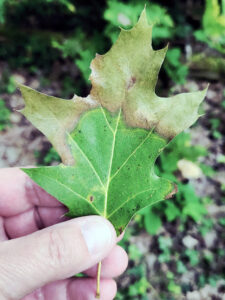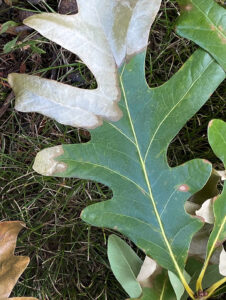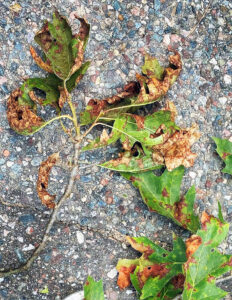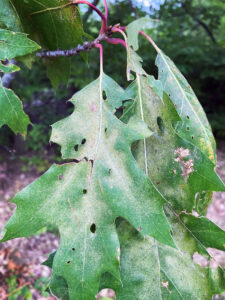
Oak wilt leaf symptoms on a red oak leaf often show browning on the outer portions of the leaf while the base of the leaf will still have some normal green color. / Photo Credit: Wisconsin DNR
By Linda Williams, DNR Forest Health specialist, Woodruff
Linda.Williams@wisconsin.gov or 920-360-0665
Oak wilt symptoms are active right now, but so are several other oak issues that may be mistaken for oak wilt.
Issues including Tubakia leaf spot, mite damage and leaf scorch are all causing problems in northern Wisconsin and may be mistaken for oak wilt.

Oak wilt leaf symptoms on a white oak leaf show browning on the outer portions of the leaf while the base of the leaf will still have some normal green color. / Photo Credit: Wisconsin DNR
Oak Wilt Leaf Symptoms
Trees in the red oak group (those with points on their leaves) that became infected with oak wilt in the spring will rapidly drop their leaves in July and August. Trees that became infected later in the high-risk period (April 15 to July 15 in northern Wisconsin) may start to drop their leaves later, in September or into October.
Leaves dropping from oak wilt trees can be fully green, tan or a water-soaked, greenish color away from the petiole (leaf stem). There will often be an area that is still green near the petiole, even though the leaf has fallen to the ground. Wilting leaves typically start near the top of the tree and progress downward.
Recommended control measures depend on if you have just one tree actively wilting (and no others have died in past years) or if you are dealing with established pockets that have been present for more than a year.
A Wisconsin Department of Natural Resources fact sheet is available that covers control options for oak wilt, or, contact your regional forest health specialist to discuss control options if you think you have oak wilt.
Tubakia Leaf Spot Symptoms

Tubakia leaf spot causes blotches of brown that can cause leaves to distort and curl. / Photo Credit: Wisconsin DNR
Tubakia leaf spot (Tubakia dryina) symptoms are typically worse in the lower canopy. Oak leaves will develop irregular brown blotches, shrivel and turn brown, with some dropping from the tree. Lower branches may lose nearly all their leaves. Branches at the top of the tree are not usually impacted, which is different from what we see with oak wilt (in which leaves often drop first from the top of the tree or the outer parts of branches).
Leaves with Tubakia leaf spot have a different pattern of mortality on the leaf than what you see with oak wilt, with brown blotches and leaf curling. In forested areas, the lower branches may die, but it doesn’t typically kill the tree, so no management is necessary.
Mites

Mite damage is often focused along the veins and causes areas of the leaf to turn tan. / Photo Credit: Wisconsin DNR
Feeding by mites can cause a tan color to appear along the veins of leaves. Leaves typically remain on the tree.
Mites insert their mouthparts into the leaf to suck the sap, which causes a small tan speck on the upper surface of the leaf. With high populations, those specks can coalesce to make the interior portions of the leaf tan in color.
Mite damage to oak leaves doesn’t usually show up until late in the growing season. Mite control can be difficult, and if damage occurs late in the season, control is generally not necessary.
Leaf Scorch Due To Heat/Drought/Stress

Leaf scorch causes interveinal leaf tissue to brown. / Photo Credit: Wisconsin DNR
Leaf scorch symptoms typically show up following hot, dry weather. Issues that can induce leaf scorch to develop include branch damage that impairs water flow to the leaves, root damage that limits water uptake, or significant nutrient imbalance.
Leaves will turn brown along the edges, and browning may extend into the leaf between the veins. Leaf veins often remain green. Damage is a symptom of a larger issue. Identification of that issue will determine whether actions can be taken.
